Fab Food Plants
How Prestage Foods of Iowa built a state-of-the-art pork processing plant
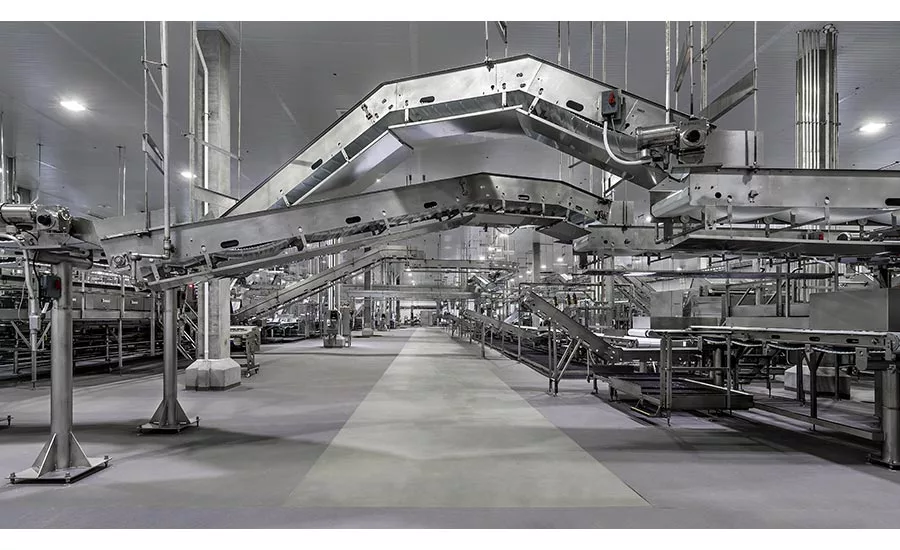
Prestage has built a world-class pork processing facility that will meet current and future needs.
Photos courtesy of Epstein
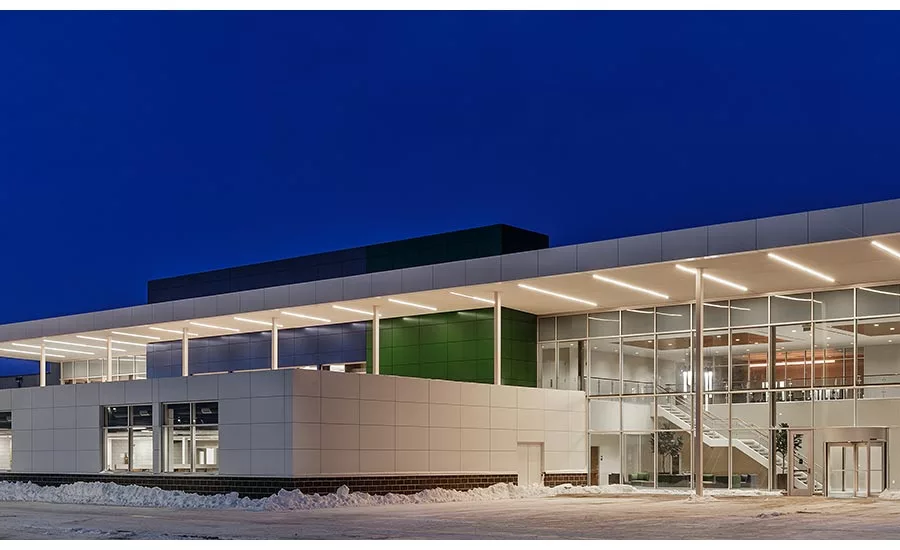
The plant’s new office and employee welfare areas are open and inviting, with a clean and modern appearance.
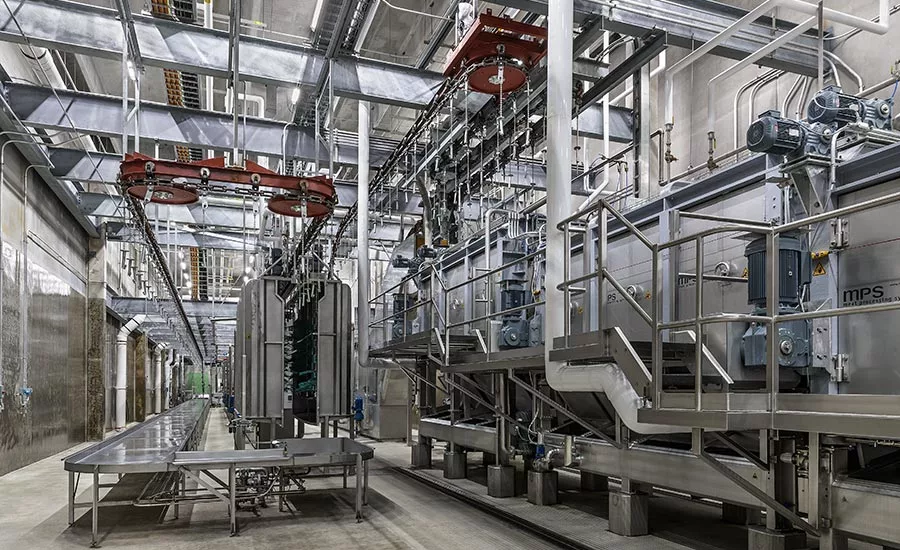

Red and white organ pans are part of the harvest room line in Prestage’s new pork processing facility.

An inside look at the singers and carcass polishing line at Prestage.
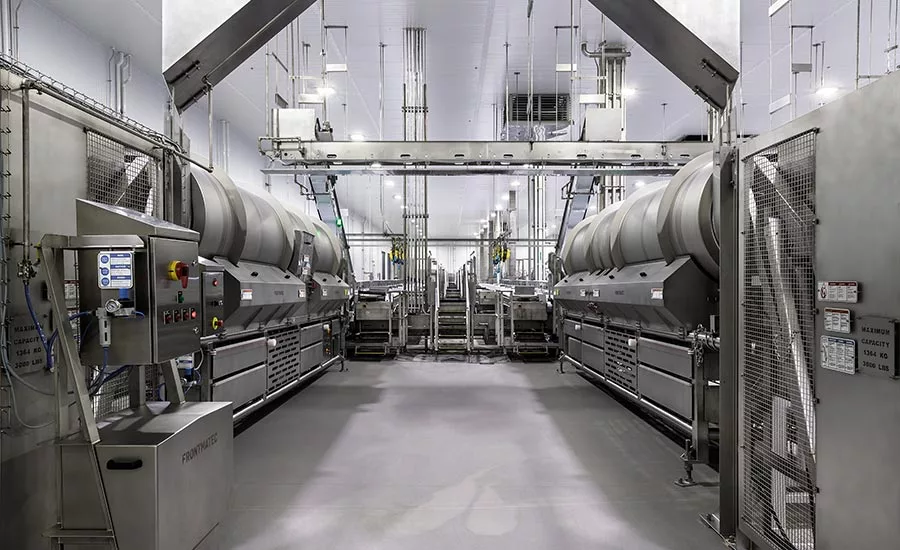
Ham tumblers feeding the ham deboning lines.
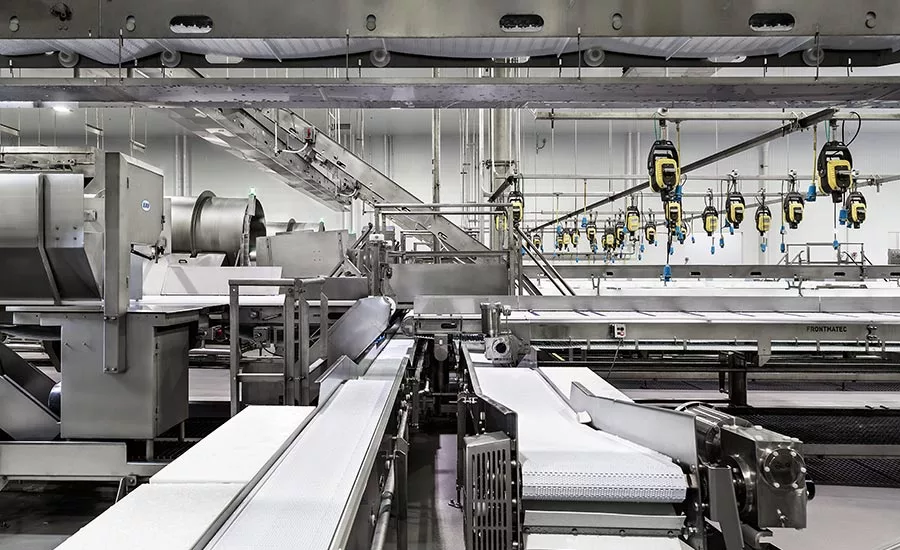







Producing more than 1.4 billion pounds of pork and turkey annually, the Prestage Farms family of companies employs more than 2,700 associates and is affiliated with more than 470 farm families across the U.S.
The company has locations in Iowa, Oklahoma, Mississippi, North Carolina and South Carolina, but its new pork processing facility in Wright County, Iowa, is the place recognized as a Fabulous Food Plant.
Article Index:
After several years of consideration, the Prestage Foods of Iowa project began in earnest in January 2016, and the facility began commercial operations on March 4, 2019. While Prestage Farms had been a hog producer for more than 30 years, the family had never owned or operated a pork processing facility. Because the team was looking to create a state-of-the-art facility that could serve the Midwest and then some, Prestage chose to work with Epstein—a Chicago-based multidisciplinary design and construction firm that had built two of the last three major pork facilities constructed in the U.S.
“Our company has provided high-quality livestock to many U.S. packers for years,” says Jere Null, CEO of Prestage Foods of Iowa. “The U.S. packing industry has consolidated in the last 25 years, leaving fewer choices for producers to market their animals to, and leaving fewer choices for retailers and distributors to purchase from,” Null says.
He says that Prestage felt there was an imbalance of packer capacity versus producer capacity that was not being addressed, which led to depressed pricing for Prestage’s livestock as well as those raised by others in the Midwest. “We believed there was a place for a family-led U.S. packer to provide options for retailers for a high level of dependable service and supply along with consistent high-quality product. We think this plant has accomplished these goals.”
Indeed, it has. The plant’s extensive automation and controls system, environmental protection features and streamlined production process show the company’s commitment to building a world-class facility that will meet current and future needs.
In Null’s words, the plant is “the most technologically advanced pork processing plant in the world. From the physical layout to the advanced technological systems and processes, this facility closely controls environmental and production attributes to produce highly predictable and consistent specifications. [We] take everything we have learned in the last 35 years with regard to quality pork production and integrate it into a series of complementary processes to enhance overall quality attributes such as taste, color and shelf life.”
While Prestage had strong opinions about the process desired, Null says the business looked to Epstein to build the infrastructure and building to support its needs. “We saw them as uniquely qualified to bring the utilities, structure and workflow that would meet our needs,” he says.
Randy Tharp, vice president and director of DesignBuild at Epstein, says, “Epstein became involved in the Prestage project as initially part of a confidential feasibility study. Given [our] extensive experience in the design and construction of meat processing plants, Prestage came to us for a study that would examine alternates for various plant volumes and the associated total capital investment, labor requirement and building/site sizes. Upon their review of the study, they decided to move forward with the project and engaged Epstein for the turnkey design, engineering, equipment procurement and construction.”
From the inside out
Null says that the project’s main goals were to create additional value for Prestage’s high-quality Midwestern livestock; create an additional outlet for livestock sales from other Midwestern producers; and serve the needs of retail, distributors and foodservice accounts that value service and consistency of product.
Tharp agrees and adds, “Prestage’s main goal was to develop a state-of-the-art processing plant that would be capable of competing with the nation’s larger pork processors, giving Prestage Farms added value through participation in an additional area of the vertical pork industry.”
With these goals in mind but having never before undertaken the development of such an extensive production facility, Prestage needed support and assistance in nearly every area of the project development, Tharp explains. “As these intensive production facilities start from the inside and work outward, Prestage first needed support in the selection of the primary harvest and cut processing equipment, which drives much of the design and layout of these new plants.”
To get started, representatives from the two companies attended a major meat processing trade show in Europe and toured a number of plants there to see equipment systems in operation. “Upon the selection of these key processing lines, we then began to develop the overall plant layout and flow,” Tharp says.
The plant layout and overall building design were then engineered and detailed for bidding to other equipment vendors and construction trade contractors by the Epstein team for actual construction in the field, which was also managed and supervised by Epstein. Null divulges that the harvest floor is primarily a Marel design. He adds that the primary equipment in “the cut” was designed and manufactured by Frontmatec, and the inedible rendering system is a Haarslev design.
“Because many of these meat processing plants are in more rural locations, employee attraction and retention are key factors in the operation of the plant,” Tharp explains. “To help support these, Epstein conceived a design for the plant which is open, inviting, well lit and which creates an attractive workplace.” He says that particular attention was paid to the design of the office and employee welfare areas to make them open and inviting, with a clean and modern appearance. “This is very atypical of most meat processing facilities,” he adds.
Providing utility services and meeting environmental goals also required special consideration, Tharp says. The plant location is in a very rural area a few miles south of the town of Eagle Grove, Iowa. “This location provides room for possible future expansion and avoids conflicts with town residents and businesses,” Tharp explains. “However, due to the distance away from town, utility services were not immediately available at the site and, because of the size of Eagle Grove, not all of the utility services required to support the plant were initially available.”
The planning and development of new high volume natural gas service, electrical service and development of facilities to provide water and wastewater treatment were critical aspects for being able to make the plant operational once the building and equipment were constructed and installed. On-site wells were drilled to provide water for the plant operations so as not to overtax the municipal system. Plus, a wastewater pretreatment plant and bio-reaction lagoons were developed to minimize impact on public waste water plants.
“Also, while the plant is located away from residences, close attention was paid to the inclusion of odor control measures, including bio-filters to address livestock barn odors, air scrubbers to address rendering building odors, and closed tanks and lagoon covers to address wastewater odors,” Tharp says.
Lean manufacturing
Null says the facility was built with process control and flow as a priority. The combination of efficient design and technology allows 920 employees to accomplish what would have taken 1,200 just 20 years ago. Features such as automatic openers, automatic neck droppers, robotic splitting saws, automatic rib pullers and water jet belly cutters all contribute to product consistency and labor efficiency.
“Additionally, inedible conveyances, live barn loadout and identification, and finished box handling all reduce needed manning and improve process flow,” Null says.
Tharp says that the Prestage plant includes the latest technologies available within the pork processing industry. The livestock stun and harvest floors feature automated controlled atmosphere stun systems that are humane and efficient, with less stress on the animals. He adds that vertical scalding is used to reduce overall water usage and improve the cleanliness of each carcass. The harvest areas utilize a significant amount of automation to provide extremely precise cutting during the evisceration process through the use of optical vision systems that direct the location for robotic saws and cut devices. Within the cut floor, processing equipment also includes vision assist systems that individually scan each carcass or primal cut of meat and determine where automatic saws and knives will cut that primal for optimum product specification and waste reduction. “These automation and technology systems combined all work to provide a consistency and uniformity of finished product,” Tharp says.
Sustainability
The plant uses proven technologies to reduce the environmental impact. Waste heat from rendering is used to make hot water, and methane gas from waste treatment is used to make steam. The vertical scald system uses 40% less water than conventional scald systems.
Additionally, Null points out that the plant uses state-of-the-art environmental technology to reduce odor emissions, including a thermal oxidizer to eliminate inedible rendering fumes, and an air filtration system on barn emissions to reduce odor from the live animal barn.
Tharp reiterates that many systems of the plant have been designed to minimize the impact on existing utility services and reduce the stress on those services.
“All process equipment and systems were planned and selected to reduce water usage, electricity usage and to provide for greater overall efficiency,” Tharp says. “The boilers for the plant produce high temperature steam that is used for multiple heating requirements, including rendering operations, high temperature sanitation water, regular hot water and even radiant heating of livestock barn floor slabs. Boilers are partially fired from captured methane generated in the waste water lagoons,” he adds.
Food safety initiatives
A range of food safety initiatives were implemented throughout the plant, including vertical cabinet scalding, which keeps carcasses from being exposed to a communal bath as done in tank scalding, reducing exposure to dirt and other elements; robotic cutting with automatic sanitizing of blades after every cut; touch-free transfer and handling of carcass; and clean in place, high-pressure belt wash systems, Tharp says.
Null adds that the harvest floor was designed to flow from stun to cooler in 34 minutes.
“This promotes the removal of body heat quicker and helps ensure the optimum meat quality and color. Additionally, the plant operates a quick-chill system at temperatures up to -25°F with heavy turbulence to speed removal of heat. Airflow patterns were designed to bring fresh conditioned air into fabrication areas and filter and exhaust harvest floor and barn air away from finished product.”
Sanitary, hygienic design
Tharp notes that within all process areas close attention was paid to making the architectural environment—including walls, ceiling and utility drops—easy to clean and sanitize.
“These (areas) include urethane floor coating with integral curb coves, stainless steel wall panels and utility piping/conduits, walk-on ceiling to reduce exposed utility services and clustered utility drops to reduce/eliminate horizontal piping/conduit within process spaces,” he says. The plant also includes its own truck wash in order for each truck entering and leaving the facility to be fully sanitized to prevent the potential spread of animal disease when returning to farm production facilities.
The facility’s CIP system for belt washing on the fabrication floors improves sanitation and reduces water waste. The plant also has boot scrubbers at entry points and multiple wash stations, both on and off the production line. Production lighting is recessed and flush with the ceiling and accessed from above, thus eliminating the need for access and cleaning in hard-to-reach areas. Utilities and equipment connections are designed for easy cleaning and not directly mounted to flat surfaces.
Employee safety
At the time of this writing, Prestage had 750 associates working on one shift, harvesting 7,500 head per day. Null expects to meet a single-shift target of 10,000 head with 920 employees by March 2020.
Employee safety was an important consideration in all areas during the design. Tharp says the processing areas are open and employee work stations were designed for access, ergonomics and adjacency to other operations.
“Openness of the plant allows for separate flows and circulation for people and conveyors and/or forklifts,” he says. “Employee locker areas are open to provide visual access to all areas, avoiding potential safety and security issues.”
The plant operates an onsite medical clinic during operational hours and employs degreed safety professionals who manage a rigorous safety program, beginning in new employee orientation and continuing through employee involvement in operational safety.
Fabulous fabrication
The $320 million, 700,000-square-foot facility includes some of the highest level of architectural design and finishes in the food industry for a processing plant.
“The exterior design of the main façade and office is very linear and emphasizes horizontal lines to reflect the open farmland on which it sits,” Tharp says. The interior design integrates the Prestage company color scheme as well as being open and reflecting the openness and lightness of the plant beyond.
The plant was designed to exceed the industry standard of 25% exports, according to Null.
“Technology provides better consistency to export markets and good refrigeration and design flow promote maximum shelf life. We are currently exporting around 30% to markets in Asia and Central and South America,” he says. “Prestage farms supplies about 60% of the animals processed by the plant. Another 30% comes from strategic partners producing livestock in Iowa. All of the livestock facilities and feed mills are regularly audited for process control and humane handling. Most livestock come from farms within 150 miles of the facility.”
Has the project met expectations? Null says, “Startups are challenging. We are very pleased with the end product. Mechanical challenges have been minimal. We are pleased with our quality.”
He goes on to say that the combination of design and technology are unmatched anywhere, but it is the quality of care and attention provided by the hundreds of Prestage team members that make this facility unique. “It is their hard work and dedication to consistency that makes this a truly outstanding facility and company.”
When asked what makes Prestage Foods of Iowa worthy of the title Fabulous Food Plant, Null says, “Our plant deserves this recognition due to the innovative and efficient design and the integration of the best technology our industry has to offer. Employee safety, food safety and efficiency are blending together seamlessly to create the perfect environment to make consistent high-quality pork products. This facility has no match anywhere in the world.”
Tharp adds, “All of the features we’ve outlined make this an exceptional state-of-the-art food processing plant. The combination of these plus the close attention paid to making the plant visually attractive and a pleasant environment for workers make it stand out amongst most any type of food plant operating in the United States, let alone within the meat industry where plants have typically been viewed as nuisances and not pleasant places to work.”
Owner Bill Prestage says that Prestage Foods of Iowa is not only dedicated to providing superior quality pork products to its consumers but also to the Iowa communities where they live.
For more information:
Prestage Food of Iowa Inc.,
www.prestagefoodsofiowa.com
Epstein,
www.epsteinglobal.com
Marel,
www.marel.com
Frontmatec,
www.frontmatec.com
Haarslev,
www.haarslev.com
“By purchasing supplies and services from local sources whenever possible, we strive to contribute back to our local economies,” he says. “We take pride in giving back when and where we can and encourage our employees to do the same.”
Finally, when asked about his operating philosophy, Prestage says, “Be fair to your employees, your growers, your colleagues and your neighbors. Don’t just follow the rules, exceed the rules. Do business with good people, make sure every business deal is beneficial for all parties involved, and above all be competitive in everything you do”—a fabulous philosophy for a fabulous food plant.
Looking for a reprint of this article?
From high-res PDFs to custom plaques, order your copy today!














